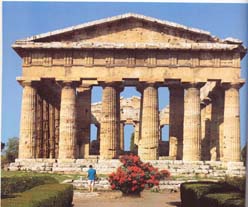
According to Strabo, Jason stopped near the mouth of the Sele river and he had a sanctuary built dedicated to Hera (Juno). Mythology is only a poetic interpretation of the historical events. Probably, in the middle of the VII century b.C. the town of Sibaris founded a commercial centre near the mouth of the Sele river, and also a sanctuary dedicated to Hera.
Later, Poseidonia – the Greek name of Paestum – was founded. In short words, Poseidonia was founded during the VII century b.C in two different stages: the first settlement (near the mouth of the Sele river) and right away the definitive settlement at a better spot. Later, during the V century b.C. the Samnites, a local population of Campania, invaded the region and this town too. But in 273 b.C. Romans managed to conquer Paestum which was totally romanized: the name of the town became “Paestum”.
During the I century A.D. a disaster took place: the river Salso, which flowed along the Southern walls of the town, flooded the fields and the town too. Probably this phenomenon was due to the fact that the pine-trees of the area were very sought-after for making the main-masts of the ships and they were totally destroyed. So, the inhabitants of Paestum had to abandon their town.
Soon the territory became a marshland. Over the centuries Paestum and its splendours fell
into oblivion. In the XV century when archeology became an active area of study, scholars
studying ancient texts came across references to the famed city of Paestum with its glorious
Greek temples - but no one could find it. Early scholars finally gave up looking for this
mysterious city in the XVII century, convinced that its story was nothing more than legend.
When the ruins of Paestum were 'rediscovered' by archaeologists — chiefly Johann Joachim
Winckelmann — in the 1750s, "the ruins [were] then made widely known, and an enthusiastic
appreciation of Greek art and architecture was also sparked...Because of Paestum, the Classic
Revival was born with Greece, not Rome, ascendant."
Paestum is famous for its Greek temples, generally recognised as being the oldest and best preserved doric temples in the world. The three Paestum temples are the so-called “Basilica”, the temples of “Neptune” and “Ceres” In addition all of them are in the Archaic Doric style of heavy columns with capitals that are squat. Like all Greek temples they face east-side, so that the rising sun will rouse the sleeping deity inside.
The National Museum of Paestum was built in 1952 in order to house the findings discovered in the nearby excavations. In this museum we can distinguish:
In the middle of the Museum You can see the metopes in sandstone found at the mouth of the Sele river. They date back to the IV century b.C. and they belonged to the Sanctuary of Hera (Juno) – Thesauros.
In this museum the collection of frescos coming from the Samnite necropolis (V century b.C.) is noteworthy.
But the masterpiece of this museum are the frescos of the so-called “the Tomb of the diver” (475 b.C.). They are very important because they are the unique example of Greek paintings in Magna Grecia (in the South Italy).